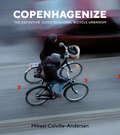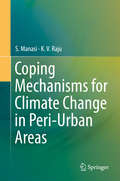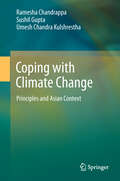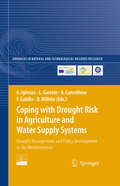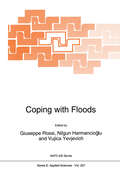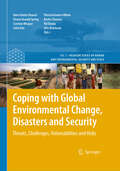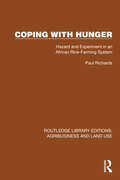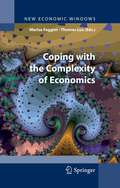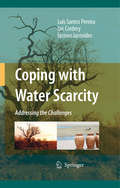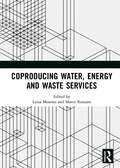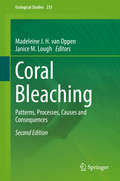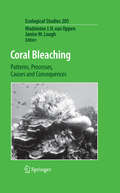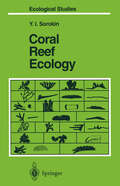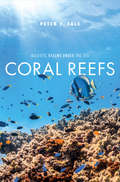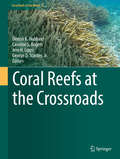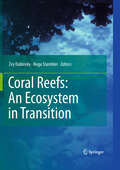- Table View
- List View
Copenhagenize: The Definitive Guide to Global Bicycle Urbanism
by Mikael Colville-AndersenThe bicycle enjoyed a starring role in urban history over a century ago, but now it is back, stronger than ever. It is the single most important tool for improving our cities. Designing around it is the most efficient way to make our cities life-sized—to scale cities for humans. It is time to cement the bicycle firmly in the urban narrative in US and global cities. Enter urban designer Mikael Colville-Andersen. He has worked for dozens of global cities on bicycle planning, strategy, infrastructure design, and communication. He is known around the world for his colorful personality and enthusiasm for the role of bike in urban design. In Copenhagenize, he shows cities how to effectively and profitably re-establish the bicycle as a respected, accepted, and feasible form of transportation. Building on his popular blog of the same name, Copenhagenize offers vivid project descriptions, engaging stories, and best practices, alongside beautiful and informative visuals to show how to make the bicycle an easy, preferred part of everyday urban life. Copenhagenize will serve as inspiration for everyone working to get the bicycle back into our cities. It will give planners and designers the ammunition to push back against the Automobile Age and convince the skeptics of the value of the life-sized city. This is not a guide on how to become Copenhagen, but how to learn from the successes and failures (yes, failures) of Copenhagen and other cities around the world that are striving to become more livable. We need to act in order to save our cities—and us—from ourselves. Copenhagenize shows the path forward.
Coping Mechanisms for Climate Change in Peri-Urban Areas
by S. Manasi K. V. RajuThis book discusses the dynamics and resource management qualities of the peri-urban interface to address climate change consequences, focusing on the peri-urban region of the global city of Bengalaru. In 5 chapters, the authors document the unique challenges experienced in peri-urban areas, including soil-water vegetation dynamics, local and regional impacts on water bodies (surface and groundwater), food production issues, and the inhibited adaptive capacity of local communities. The book also provides knowledge on implementations of environmental management by local institutions, government interventions that have acted as catalysts in promoting community based adaptation strategies, and the physical, social and economic aspects of rural-urban dynamics. The book not only adds to the scarce existing literature on peri-urban contexts, but also addresses the role of culture in protecting ecological landscapes and how traditions play an important role in coping with climate change. Furthermore, the authors expand on these climate change coping mechanisms in peri-urban areas, taking into account local cultural factors and interesting governance interventions in the context of health. The book will be of interest to planners, policy makers, and students and researchers engaged in rural-urban dynamics and climate change adaptation.
Coping with Climate Change: Principles and Asian Context
by Ramesha Chandrappa Sushil Gupta Umesh Chandra KulshresthaThe Environmental and climatic issues varies from continent to continent and is unique to Asia. Understanding the issues does need lot of research and study material which students may not be able to gather due to shortage of time and resources. Hence an effort is made by authors gathering there experience and academic input from renowned universities of world. Climate change is real and coping with it is major concern in coming days. Most of the books written and sold in the past need updating and customizing. The general description of climate change and world will not help the professionals and students. It needs to seen area wise as a professional will work in specific geographic area. Hence an effort is made to collect data from Asia which host most populated countries along with ecological hot spots.
Coping with Complexity: Model Reduction and Data Analysis (Lecture Notes in Computational Science and Engineering #75)
by Alexander N. Gorban Dirk RooseThis volume contains the extended version of selected talks given at the international research workshop "Coping with Complexity: Model Reduction and Data Analysis", Ambleside, UK, August 31 – September 4, 2009. The book is deliberately broad in scope and aims at promoting new ideas and methodological perspectives. The topics of the chapters range from theoretical analysis of complex and multiscale mathematical models to applications in e.g., fluid dynamics and chemical kinetics.
Coping with Drought Risk in Agriculture and Water Supply Systems: Drought Management and Policy Development in the Mediterranean (Advances in Natural and Technological Hazards Research #26)
by Antonio Cancelliere Francisco Cubillo Luis Garrote Donald A. Wilhite Ana IglesiasOver the last three decades drought episodes have resulted in severe social problems in Mediterranean countries, receiving broad attention from the international scientific and policy communities. The experiences in the development and implementation of drought management plans highlight the success and challenges of coping with drought for societies with different vulnerabilities and emphasize risk-based drought management as a critical approach to mitigate the impacts associated to drought-induced water shortages. Based on these experiences and the current methods for evaluating risk, the book synthesises guidelines for drought management that link science and policy and that can be applied to other regions. The book comprises a collection of papers divided into four sections that appeal to a broad audience. First, the social and hydrological context of Mediterranean countries is presented, discussing the interactions that have resulted in the complex institutional framework, and highlighting the importance of stakeholder involvement and awareness building for successful drought management. This section emphasises the role of organizations, institutions, and civil stakeholders involved in drought preparedness and mitigation and/or on water management for designing effective risk based strategies that mitigate the effects of drought in agriculture and water supply systems. Second, the book presents an academic approach to risk evaluation, including characterization of drought episodes, development of indicators of risk in hydrological and agricultural systems, and analysis of the role of economic instruments and groundwater for risk mitigation. This section finalises with the description of an integrated method for evaluating social vulnerability based on indicators that include the capacity to anticipate, cope, and respond to drought.The third section includes a collection of case studies that include the description of effective measures taken in the past. These case studies provide the context for developing demand driven guidelines that may be applied to other regions. The authors of these chapters can be viewed as stakeholders in drought management, since they represent a broad range of sectors and institutions from Mediterranean European and North African countries. The topics addressed have implications for the international policy community interested in disaster mitigation, agricultural policy, and development. Finally a synthesis of the management actions is presented in four chapters. Monitoring and preparedness planning is the essential first step for moving from disaster to risk management in response to drought. The management actions related to agriculture and water supply systems are presented in two different chapters but with a common conceptual framework based on the use of drought indicators for evaluating the levels of drought risk (pre-alert, alert, and emergency), that allow establishing linkages between science and policy. The final chapter discuses the lessons learned and application to other regions.
Coping With Flash Floods (NATO Science Partnership Subseries: 2 #77)
by JohnHandmer EveGruntfestThis volume is the proceedings of a NATO-sponsored Advanced Study Institute (ASI) entitled "Coping with Flash Floods" held in Ravello, Italy on 8-17 November 1999. Thirty-five participants from nine countries attended the ASI, representing both developed (United States, England, Italy, and Mexico) and developing (Poland, Uganda, Greece, Ukraine, and Slovenia) countries. Participants from a variety of professions and disciplines were involved including a hydraulics engineering professor from Slovenia, four members from the Polish Institute of Meteorology and Water Management, and a U. S. Geological Survey research hydrologist from Puerto Rico. Although the ASI was officially composed of lecturers and students, these roles were blurred as each person shared information and ideas, and learned from the other participants during the 10 days. One of the highlights of the ASI was the collaborative effort of participants from different countries and disciplines. It was particularly extraordinary that the two engineers from Greece made the most passionate pleas for long term sustainable solutions to flash floods. A further example is that while there were only three participants with social science backgrounds, most of the recommendations focus on the policy and societal priorities, more than the engineering, hydrologic or meteorologic efforts.
Coping with Floods (NATO Science Series E: #257)
by Giuseppe Rossi Nilgun B. Harmanciogammalu V. YevjevichFloods are natural hazards whose effects can deeply affect the economic and environmental equilibria of a region. Quality of life of people living in areas close to rivers depends on both the risk that a flood would occur and the reliability of flood forecast, warning and control systems. Tools for forecasting and mitigating floods have been developed through research in the recent past. Two innovations currently influence flood hazard mitigation, after many decades of lack of significant progress: they are the development of new technologies for real-time flood forecast and warning (based on weather radars and satellites) and a shift from structural to non-structural flood control measures, due to increased awareness of the importance of protecting the environment and the adverse impacts of hydraulic works on it. This book is a review of research progress booked in the improvements of forecast capability and the control of floods. Mostly the book presents the results of recent research in hydrology, modern techniques of real-time forecast and warning, and ways of controlling floods for smaller impacts on the environment. A number of case studies of floods in different geographical areas are also presented. Scientists and specialists working in fields of hydrology, environmental protection and hydraulic engineering will appreciate this book for its theoretical and practical content.
Coping with Global Environmental Change, Disasters and Security: Threats, Challenges, Vulnerabilities and Risks (Hexagon Series on Human and Environmental Security and Peace #5)
by Hans Günter Brauch Úrsula Oswald Spring Czeslaw Mesjasz John Grin Patricia Kameri-Mbote Béchir Chourou Pál Dunay Joern BirkmannCoping with Global Environmental Change, Disasters and Security - Threats, Challenges, Vulnerabilities and Risks reviews conceptual debates and case studies focusing on disasters and security threats, challenges, vulnerabilities and risks in Europe, the Mediterranean and other regions. It discusses social science concepts of vulnerability and risks, global, regional and national security challenges, global warming, floods, desertification and drought as environmental security challenges, water and food security challenges and vulnerabilities, vulnerability mapping of environmental security challenges and risks, contributions of remote sensing to the recognition of security risks, mainstreaming early warning of conflicts and hazards and provides conceptual and policy conclusions.
Coping with Hunger: Hazard and Experiment in an African Rice-Farming System (Routledge Library Editions: Agribusiness and Land Use #22)
by Paul RichardsOriginally published in 1986, Coping with Hunger demonstrates that effective agricultural development in resource-poor regions must be based in a respect for the indigenous farmer’s understanding of the environment. Based on participant-observation of rice farming in Sierra Leone, the book challenges the prevailing of attitudes of policy makers in the late 20th Century and restores indigenous culture and local wisdom to their rightful place. After analysing the fate of a number of ‘top-down ‘attempts to improve rice cultivation in Sierra-Leone the author derives an alternative agenda of research and development issues more closely reflecting the resource-poor farmers’ major interests and priorities. As a significant research-based contribution to the widespread general debates about the relevance of social factors in technological change, this book will be of interest to students in social and environmental sciences.
Coping with Hunger: Hazard and Experiment in an African Rice-Farming System (Routledge Library Editions: Agribusiness and Land Use #22)
by Paul RichardsOriginally published in 1986, Coping with Hunger demonstrates that effective agricultural development in resource-poor regions must be based in a respect for the indigenous farmer’s understanding of the environment. Based on participant-observation of rice farming in Sierra Leone, the book challenges the prevailing of attitudes of policy makers in the late 20th Century and restores indigenous culture and local wisdom to their rightful place. After analysing the fate of a number of ‘top-down ‘attempts to improve rice cultivation in Sierra-Leone the author derives an alternative agenda of research and development issues more closely reflecting the resource-poor farmers’ major interests and priorities. As a significant research-based contribution to the widespread general debates about the relevance of social factors in technological change, this book will be of interest to students in social and environmental sciences.
Coping with the Complexity of Economics (New Economic Windows)
by Marisa Faggini Thomas LuxThroughout the history of economics, a variety of analytical tools have been borrowed from the so-called exact sciences. As Schoe?er (1955) puts it: “They have taken their mathematics and their ded- tive techniques from physics, their statistics from genetics and agr- omy, their systems of classi?cation from taxonomy and chemistry, their model-construction techniques from astronomy and mechanics, and their methods of analysis of the consequences of actions from en- neering”. The possibility of similarities of structure in mathematical models of economic and physical systems has been an important f- tor in the development of neoclassical theory. To treat the state of an economy as an equilibrium, analogous to the equilibrium of a mech- ical system has been a key concept in economics ever since it became a mathematically formalized science. Adopting a Newtonian paradigm neoclassical economics often is based on three fundamental concepts. Firstly, the representative agent who is a scale model of the whole society with extraordinary capacities, particularly concerning her - pability of information processing and computation. Of course, this is a problematic reduction as agents are both heterogeneous and bou- edly rational and limited in their cognitive capabilities. Secondly, it often con?ned itself to study systems in a state of equilibrium. But this concept is not adequate to describe and to support phenomena in perpetual motion.
Coping with Water Scarcity: Addressing the Challenges
by Luis Santos Pereira Ian Cordery Iacovos IacovidesOne of the main problems confronting the world of the 21st Century is a shortage of water. There is already severe scarcity in many regions of the world, causing tremendous problems for local populations and indeed entire societies. There is insufficient water available for the production of food to alleviate poverty and starvation; the lack of water hampers industrial, urban and tourism development, forcing restrictions on other sectors, especially agriculture; health problems arise as the deterioration of ground and surface waters favours water-borne diseases, which flourish in the absence of decent water distribution and sewerage systems. Water conflicts still arise in areas under stress, while water for nature has become a vanishing priority in such zones. This book is a guide to the establishment of regional and/or local guidelines for developing and implementing new ideas for coping with water scarcity. The basic premise underlying the book is that water scarcity will persist, so personal, human and society-wide skills will be needed to cope with it while living in harmony with the necessary environmental constraints. The book provides basic information to assist decision makers, water managers, engineers, agronomists, social scientists and other professions (and their students) in formulating coherent, hopefully harmonious and consolidated views on the issue. Guidelines are also given for introducing the general public to the concept of water scarcity and how to deal with it.
Coproducing Water, Energy and Waste Services
by Luisa Moretto and Marco RanzatoConventional services, such as water, energy and waste services, have been for a long time physically networked and centrally managed. Today, this delivery model appears increasingly inefficient in two respects. It often fails in guaranteeing its financial viability and equitable service access, and and it generally draws heavily on the natural resources conveyed by these services. The book aims thus at exploring how service coproduction, based on public-community collaborations, can represent a valuable alternative to the conventional service provision model. Contributions in this book look into service coproduction and its relationship with the conventional service model both in the Global North (Germany) and Global South (Bolivia, Brazil, Colombia, India, Tanzania). They also address a variety of different perspectives in coproducing conventional services, such as the role of service modernisation, the variety of non-networked solutions, the relationship with the commons, just to cite some of them. Eventually, this book provides a first comprehensive exploration of the service coproduction theory in relation to conventional services, such as water, energy and waste. The chapters originally published as a special issue in Urban Research & Practice.
Coproducing Water, Energy and Waste Services
by Luisa Moretto Marco RanzatoConventional services, such as water, energy and waste services, have been for a long time physically networked and centrally managed. Today, this delivery model appears increasingly inefficient in two respects. It often fails in guaranteeing its financial viability and equitable service access, and and it generally draws heavily on the natural resources conveyed by these services. The book aims thus at exploring how service coproduction, based on public-community collaborations, can represent a valuable alternative to the conventional service provision model. Contributions in this book look into service coproduction and its relationship with the conventional service model both in the Global North (Germany) and Global South (Bolivia, Brazil, Colombia, India, Tanzania). They also address a variety of different perspectives in coproducing conventional services, such as the role of service modernisation, the variety of non-networked solutions, the relationship with the commons, just to cite some of them. Eventually, this book provides a first comprehensive exploration of the service coproduction theory in relation to conventional services, such as water, energy and waste. The chapters originally published as a special issue in Urban Research & Practice.
Copulas and Its Application in Hydrology and Water Resources (Springer Water)
by Lu Chen Shenglian GuoThis book presents an overview of copula theory and its application in hydrology, and provides valuable insights, useful methods and practical applications for multivariate hydrological analysis using copulas. In addition, it extends the traditional bivariate model to trivariate or multivariate models. The specific applications covered include the study of flood frequency analysis, drought frequency analysis, dependence analysis, flood coincidence risk analysis and statistical simulation using copulas. The book offers a valuable guide for researchers, scientists and engineers working in hydrology and water resources, and will also benefit graduate or doctoral students with a basic grasp of copula functions who want to learn about the latest research developments in the field.
Coral Bleaching: Patterns, Processes, Causes and Consequences (Ecological Studies #233)
by Madeleine J. van Oppen Janice M. LoughOne of the most serious consequences of global climate change for coral reefs is the increased frequency and severity of mass coral bleaching events and, since the first edition of this volume was published in 2009, there have been additional mass coral bleaching events. This book provides comprehensive information on the causes and consequences of coral bleaching for coral reef ecosystems, from the genes and microbes involved in the bleaching response, to individual coral colonies and whole reef systems. It presents detailed analyses of how coral bleaching can be detected and quantified and reviews future scenarios based on modeling efforts and the potential mechanisms of acclimatisation and adaptation. It also briefly discusses emerging research areas that focus on the development of innovative interventions aiming to increase coral climate resilience and restore reefs.
Coral Bleaching: Patterns, Processes, Causes and Consequences (Ecological Studies #205)
by Madeleine J. H. Van Oppen Janice M. LoughOne of the most dire consequences of global climate change for coral reefs is the increased frequency and severity of mass coral bleaching events. This volume provides information on the causes and consequences of coral bleaching for coral reef ecosystems, from the level of individual colonies to ecosystems and at different spatial scales, as well as a detailed analysis of how it can be detected and quantified. Future scenarios based on modelling efforts and the potential mechanisms of acclimatisation and adaptation are reviewed. The much more severe coral bleaching events experienced on Caribbean coral reefs (compared with those of the Indo-Pacific) are discussed, as are the differences in bleaching susceptibility and recovery that have been observed on smaller geographic scales.
Coral Health and Disease
by Eugene Rosenberg Yossi LoyaThis book opens with case studies of reefs in the Red Sea, Caribbean, Japan, Indian Ocean and the Great Barrier Reef. A section on microbial ecology and physiology describes the symbiotic relations of corals and microbes, and the microbial role in nutrition or bleaching resistance of corals. Coral diseases are covered in the third part. The volume includes 50 color photos of corals and their environments
Coral Reef Conservation and Restoration in the Omics Age (Coral Reefs of the World #15)
by Madeleine J. H. van Oppen Manuel Aranda LastraThe rapid demise of coral reefs worldwide has spurred efforts to develop innovative conservation and restoration methods. Many of these rely on omics approaches to produce genetic, genomic, transcriptomic, epigenomic or metabolomic data to inform conservation and restoration interventions. This book provides the state of play of this field. It discusses topics ranging from how genomic and environmental DNA (eDNA) data can be used to inform marine protected area design and cryopreservation strategies, the use of knowledge on adaptive genetic and epigenetic variation to maximise environmental stress tolerance of coral stock, harnessing transcriptome data to develop early warning markers, the use of microbial symbiont omics data in guiding restoration strategies, to applications of metabolomics and genetic engineering. How best to translate omics data to resource managers is also discussed.
Coral Reef Ecology (Ecological Studies #102)
by Yuri I. SorokinCoral reef communities are among the most complex, mature and productive ecosystems on earth. Their activity resulted in the creation of vast lime constructions. Being extremely productive and having the function of a powerful biofilter, coral reefs play an important role in global biogeochemical processes and in the reproduction of food resources in tropical marine regions. All aspects of coral reef science are covered systematically and on the basis of a holistic ecosystem approach. The geological history of coral reefs, their geomorphology as well as biology including community structure of reef biota, their functional characteristics, physiological aspects, biogeochemical metabolism, energy balance, environmental problems and management of resources are treated in detail.
Coral Reef Remote Sensing: A Guide for Mapping, Monitoring and Management
by James A. Goodman, Samuel J. Purkis and Stuart R. PhinnRemote sensing stands as the defining technology in our ability to monitor coral reefs, as well as their biophysical properties and associated processes, at regional to global scales. With overwhelming evidence that much of Earth’s reefs are in decline, our need for large-scale, repeatable assessments of reefs has never been so great. Fortunately, the last two decades have seen a rapid expansion in the ability for remote sensing to map and monitor the coral reef ecosystem, its overlying water column, and surrounding environment.Remote sensing is now a fundamental tool for the mapping, monitoring and management of coral reef ecosystems. Remote sensing offers repeatable, quantitative assessments of habitat and environmental characteristics over spatially extensive areas. As the multi-disciplinary field of coral reef remote sensing continues to mature, results demonstrate that the techniques and capabilities continue to improve. New developments allow reef assessments and mapping to be performed with higher accuracy, across greater spatial areas, and with greater temporal frequency. The increased level of information that remote sensing now makes available also allows more complex scientific questions to be addressed. As defined for this book, remote sensing includes the vast array of geospatial data collected from land, water, ship, airborne and satellite platforms. The book is organized by technology, including: visible and infrared sensing using photographic, multispectral and hyperspectral instruments; active sensing using light detection and ranging (LiDAR); acoustic sensing using ship, autonomous underwater vehicle (AUV) and in-water platforms; and thermal and radar instruments.Emphasis and AudienceThis book serves multiple roles. It offers an overview of the current state-of-the-art technologies for reef mapping, provides detailed technical information for coral reef remote sensing specialists, imparts insight on the scientific questions that can be tackled using this technology, and also includes a foundation for those new to reef remote sensing. The individual sections of the book include introductory overviews of four main types of remotely sensed data used to study coral reefs, followed by specific examples demonstrating practical applications of the different technologies being discussed. Guidelines for selecting the most appropriate sensor for particular applications are provided, including an overview of how to utilize remote sensing data as an effective tool in science and management. The text is richly illustrated with examples of each sensing technology applied to a range of scientific, monitoring and management questions in reefs around the world. As such, the book is broadly accessible to a general audience, as well as students, managers, remote sensing specialists and anyone else working with coral reef ecosystems.
Coral Reef Science: Strategy for Ecosystem Symbiosis and Coexistence with Humans under Multiple Stresses (Coral Reefs of the World #5)
by Hajime KayanneThis book aims to illuminate coral reefs which comprise a symbiotic system coexisting among ecosystems, landforms, and humans at various levels and to provide a scientific basis for its reconstruction. The authors conducted an interdisciplinary project called “Coral Reef Science” from 2008 to 2012 and obtained novel results and clues to unite different disciplines for a coral reef as a key ecosystem.
Coral Reefs: Majestic Realms under the Sea
by Peter F. SaleAn eye-opening introduction to the complexity, wonder, and vital roles of coral reefs When mass coral bleaching and die†‘offs were first identified in the 1980s, and eventually linked to warming events, the scientific community was sure that such a dramatic and unambiguous signal would serve as a warning sign about the devastating effects of global warming. Instead, most people ignored that warning. Subsequent decades have witnessed yet more degradation. Reefs around the world have lost more than 50 percent of their living coral since the 1970s. In this book, distinguished marine ecologist Peter F. Sale imparts his passion for the unexpected beauty, complexity, and necessity of coral reefs. By placing reefs in the wider context of global climate change, Sale demonstrates how their decline is more than simply a one†‘off environmental tragedy, but rather an existential warning to humanity. He offers a reframing of the enormous challenge humanity faces as a noble venture to steer the planet into safe waters that might even retain some coral reefs.
Coral Reefs at the Crossroads (Coral Reefs of the World #6)
by Dennis K. Hubbard Caroline S. Rogers Jere H. Lipps George D. Stanley Jr.In this book, contributors from diverse backgrounds take a first step toward an integrated view of reefs and the significance of their recent decline. More than any other earth system, coral reefs sit at a disciplinary crossroads. Most recently, they have reached another crossroads - fundamental changes in their bio-physical structure greater than those of previous centuries or even millennia. Effective strategies to mitigate recent trends will require an approach that embraces the myriad perspectives from across the scientific landscape, but will also need a mechanism to transform scientific understanding into social will and political implementation.
Coral Reefs: An Ecosystem in Transition
by Zvy Dubinsky and Noga StamblerThis book covers in one volume materials scattered in hundreds of research articles, in most cases focusing on specialized aspects of coral biology. In addition to the latest developments in coral evolution and physiology, it presents chapters devoted to novel frontiers in coral reef research. These include the molecular biology of corals and their symbiotic algae, remote sensing of reef systems, ecology of coral disease spread, effects of various scenarios of global climate change, ocean acidification effects of increasing CO2 levels on coral calcification, and damaged coral reef remediation. Beyond extensive coverage of the above aspects, key issues regarding the coral organism and the reef ecosystem such as calcification, reproduction, modeling, algae, reef invertebrates, competition and fish are re-evaluated in the light of new research and emerging insights. In all chapters novel theories as well as challenges to established paradigms are introduced, evaluated and discussed. This volume is indispensible for all those involved in coral reef management and conservation.
